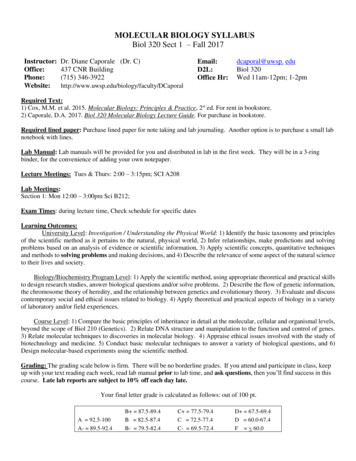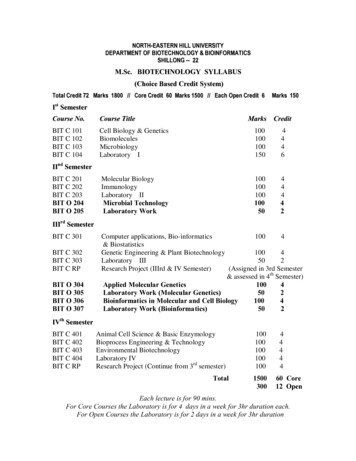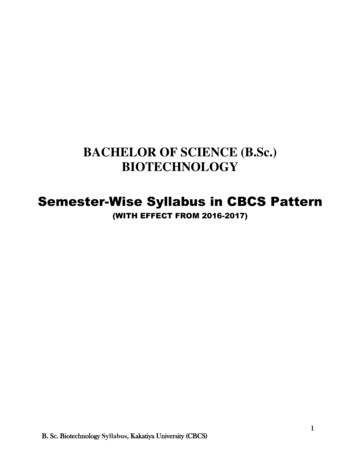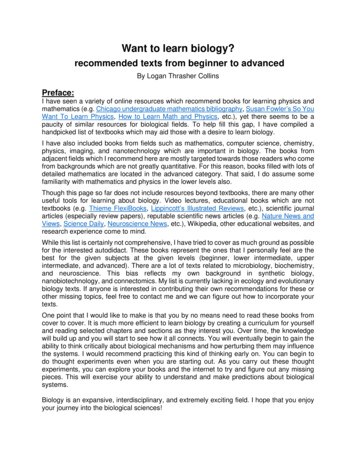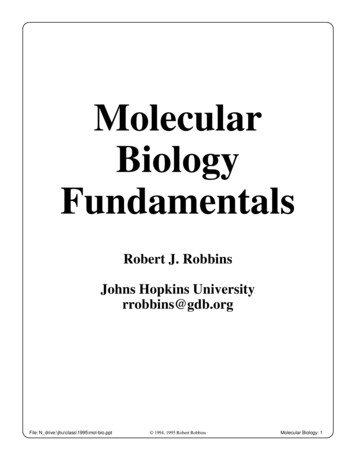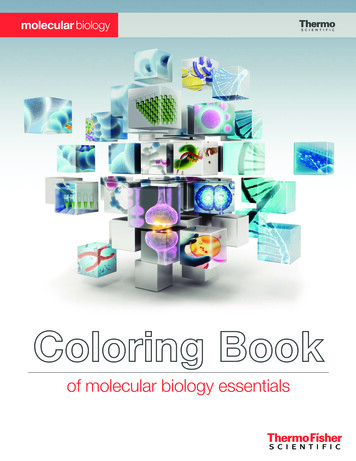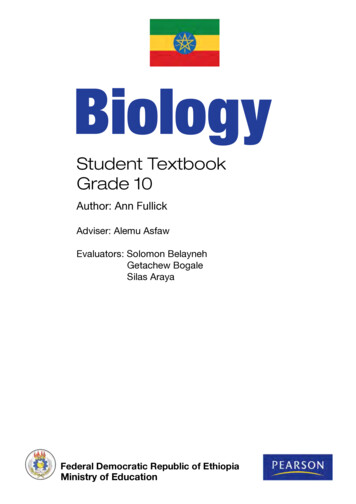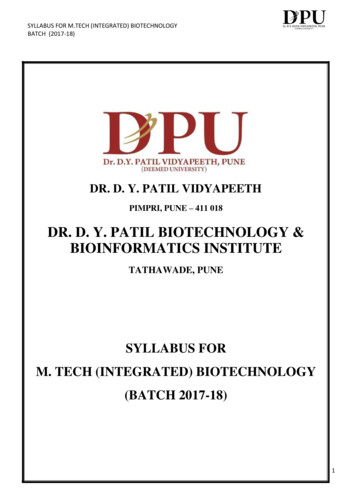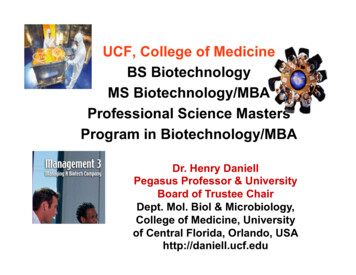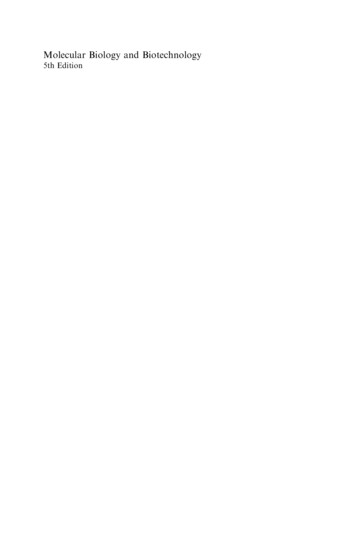
Transcription
Molecular Biology and Biotechnology5th Edition
Molecular Biology andBiotechnology5th EditionEdited byJohn M WalkerSchool of Life Sciences, University of Hertfordshire, Hatfield, HertfordshireAL10 9AB, UKRalph RaplySchool of Life Sciences, University of Hertfordshire, Hatfield, HertfordshireAL10 9AB, UK
ISBN: 978-0-85404-125-1A catalogue record for this book is available from the British Libraryr Royal Society of Chemistry, 2009All rights reservedApart from fair dealing for the purposes of research for non-commercial purposes or forprivate study, criticism or review, as permitted under the Copyright, Designs and PatentsAct 1988 and the Copyright and Related Rights Regulations 2003, this publication may notbe reproduced, stored or transmitted, in any form or by any means, without the priorpermission in writing of The Royal Society of Chemistry or the copyright owner, or in thecase of reproduction in accordance with the terms of licences issued by the CopyrightLicensing Agency in the UK, or in accordance with the terms of the licences issued by theappropriate Reproduction Rights Organization outside the UK. Enquiries concerningreproduction outside the terms stated here should be sent to The Royal Society of Chemistryat the address printed on this page.Published by The Royal Society of Chemistry,Thomas Graham House, Science Park, Milton Road,Cambridge CB4 0WF, UKRegistered Charity Number 207890For further information see our website at www.rsc.org
PrefaceOne of the exciting aspects of being involved in the field of molecularbiology is the ever-accelerating rate of progress, both in the development of new methodologies and in the practical applications of thesemethodologies. Indeed, such developments led to the idea of the firstedition of Molecular Biology and Biotechnology and subsequent editions have reflected the fast-moving nature of the area, not least thislatest edition, which continues to reflect recent developments, withnew chapters in developing areas such as genome technology, nanobiotechnology, regenerative medicine and biofuels.The first six chapters deal with the technology used in current molecular biology and biotechnology. These deal primarily with core nucleicacid techniques and protein expression through microbial and geneticdetection methods. Further chapters address the huge advances made ingene and genome analysis and update the rapid advances into yeastanalysis, which is providing very exciting insights into molecular pathways. Molecular biology also continues to affect profoundly progress inbiotechnology in areas such as vaccine development, use and applicationof monoclonal antibodies, clinical treatment and diagnosis, the production of transgenic animals, and many other areas of research relevantto the pharmaceutical industry. Chapters on all these areas have beenretained and fully updated in this new edition and new chapters introduced on the applications of molecular biology in the areas of drugdesign and diseases, and regenerative medicine. In addition, we continueto ensure that biotechnology is not just considered at the gene level andfull consideration continues to be given to applications andMolecular Biology and Biotechnology, 5th EditionEdited by John M Walker and Ralph Rapleyr Royal Society of Chemistry 2009Published by the Royal Society of Chemistry, www.rsc.orgv
viPrefacemanufacturing, with chapters on downstream processing, biosensors,the applications of immobilised biocatalysts, and a new chapter on thedeveloping area of biofuels.Our continued intention is that this book should primarily have ateaching function. As such, this book should prove of interest both toundergraduates studying for biological or chemical qualifications and topostgraduate and other scientific workers who need a sound introduction to this ever rapidly advancing and expanding area.John M. WalkerRalph Rapley
ContentsChapter 1Basic Molecular Biology TechniquesRalph Rapley1.11.2Enzymes Used in Molecular BiologyIsolation and Separation of Nucleic Acids1.2.1 Isolation of DNA1.2.2 Isolation of RNA1.3 Electrophoresis of Nucleic Acids1.4 Restriction Mapping of DNA Fragments1.5 Nucleic Acid Analysis Methods1.5.1 DNA Blotting1.5.2 RNA Blotting1.6 Gene Probe Derivation1.7 Labelling DNA Gene Probe Molecules1.7.1 End Labelling of DNA Molecules1.7.2 Random Primer Labelling1.7.3 Nick Translation1.8 The Polymerase Chain ReactionReferencesChapter 2133568891011121314151518Molecular Cloning and Protein ExpressionStuart Harbron2.12.22.32.4IntroductionHost-related IssuesVectorsExpression Systems2.4.1 The pET Expression System2.4.2 The pBAD Expression SystemMolecular Biology and Biotechnology, 5th EditionEdited by John M Walker and Ralph Rapleyr Royal Society of Chemistry 2009Published by the Royal Society of Chemistry, www.rsc.orgvii202124303033
viiiContents2.52.6ProblemsFusion Proteins2.6.1 Solubility-enhancing Tags2.6.2 Purification-facilitating Tags2.6.3 HT Approaches2.7 Other Hosts2.8 Cell-free Systems2.9 ConclusionReferencesChapter 3Molecular DiagnosticsLaura J. Tafe, Claudine L. Bartels, Joel A. Lefferts andGregory J. Tsongalis3.1 Introduction3.2 Technologies3.3 The Infectious Disease Paradigm3.4 Genetics3.5 Hematology3.6 Oncology3.7 Pharmacogenomics3.8 ConclusionReferencesChapter 4343737404344444545515253555962657171Molecular Microbial DiagnosticsKarl-Henning Kalland4.14.24.34.4IntroductionClassical Microbiological DiagnosisSample Collection and Nucleic Acid Purification4.3.1 Sample Collection and Transport4.3.2 Extraction of Nucleic Acids4.3.3 Manual Extraction of Nucleic Acids4.3.4 Automated Extraction of Nucleic AcidsNucleic Acid Amplification Techniques4.4.1 Polymerase Chain Reaction (PCR)4.4.2 The Contamination Problem4.4.3 Reverse PCR – cDNA Synthesis4.4.4 Nested PCR4.4.5 Real-time PCR4.4.6 Visualisation of Real-time PCR Amplification4.4.7 Real-time PCR Equipment4.4.8 Real-time Quantitative PCR4.4.9 Determination of ‘Viral Load’ in 8687
ixContents4.4.10Internal Controls in MicrobiologicalReal-time qPCR4.4.11 Multiplex Real-time PCR4.4.12 Melting Curve Analysis4.4.13 Genotyping4.5 Other Techniques Used in Clinical Microbiology4.5.1 Hybridisation Techniques4.5.2 Nucleic Acid-based Typing of Bacteria4.5.3 Pyrosequencing4.5.4 TaqMan Low-density Arrays (TLDAs)4.6 Selected Examples of Clinical NucleicAcid-based Diagnosis4.6.1 Central Nervous System (CNS) Disease4.6.2 Respiratory Infections4.6.3 Hepatitis4.6.4 Gastroenteritis4.6.5 Sexually Transmitted Diseases4.6.6 HIV Infection and AIDS4.6.7 Bacterial Antibiotic Resistance and VirulenceFactor Genes4.7 Conclusion and Future ChallengesReferencesChapter es and GenomesDavid B. Whitehouse5.15.25.35.4Introduction5.1.1 BackgroundKey DNA Technologies5.2.1 Molecular Cloning Outline5.2.2 Cloning Vectors5.2.3 The Cloning Process5.2.4 DNA LibrariesThe Polymerase Chain Reaction (PCR)5.3.1 Steps in the PCR5.3.2 PCR Primer Design and Bioinformatics5.3.3 Reverse Transcriptase PCR (RT-PCR)5.3.4 Quantitative or Real-time PCRDNA Sequencing5.4.1 Dideoxynucleotide ChainTerminators5.4.2 Sequencing Double-stranded DNA5.4.3 PCR Cycle Sequencing5.4.4 Automated DNA Sequencing5.4.5 128129129130130131
xContents5.5Genome Analysis5.5.1 Mapping and Identifying Genes5.5.2 Tools for Genetic Mapping5.5.3 Mutation Detection5.6 Genome Projects Background5.6.1 Mapping and Sequencing Strategies5.7 Gene Discovery and Localisation5.7.1 Laboratory Approaches5.7.2 Bioinformatics Approaches5.8 Future DirectionsReferencesChapter 6The Biotechnology and Molecular Biology of YeastBrendan P. G. Curran and Virginia C. Bugeja6.16.2IntroductionThe Production of Heterologous Proteins by Yeast6.2.1 The Yeast Hosts6.2.2 Assembling and Transforming AppropriateDNA Constructs into the Hosts6.2.3 Ensuring Optimal Expression of the DesiredProtein6.3 From Re-engineering Genomes to Constructing NovelSignal and Biochemical Pathways6.3.1 Large-scale Manipulation of Mammalian andBacterial DNA6.3.2 Novel Biological Reporter Systems6.3.3 Novel Biochemical Products IncludeHumanised EPO6.4 Yeast as a Paradigm of Eukaryotic Cellular Biology6.4.1 Genomic Insights6.4.2 Transcriptomes, Proteomes and Metabolomesand Drug Development6.4.3 Systems Biology6.5 Future ProspectsReferencesChapter 70170176179187187188190191191Metabolic EngineeringStefan Kempa, Dirk Walther, Oliver Ebenhoeh and WolframWeckwerth7.17.2IntroductionTheoretical Approaches for Metabolic Networks7.2.1 Kinetic Modelling196197198
xiContents7.2.2Metabolic Control Analysis (MCA),Elementary Flux Modes (EFM) andFlux-balance Analysis (FBA)7.3 Experimental Approaches for Metabolic Engineering7.3.1 Tools for Metabolic Engineering7.3.2 Metabolomics7.3.3 Metabolomics in the Context of MetabolicEngineering7.4 Examples in Metabolic Engineering7.4.1 Metabolic Engineering of Plants7.4.2 Acetate Metabolism and Recombinant ProteinSynthesis in E. coli – a Test Case for MetabolicEngineering7.4.3 Metabolic Flux Analysis and a Bioartificial Liver7.5 Omics Technologies Open New Perspectives forMetabolic Engineering7.6 AcknowledgementReferencesChapter 8210211211213213214215215BionanotechnologyDavid W. Wright8.18.2IntroductionSemiconductor Quantum Dots8.2.1 Quantum Confinement Effects8.2.2 Biotechnological Applications of FluorescentSemiconductor Quantum Dots8.3 Magnetic Nanoparticles8.3.1 Nanoscaling Laws and Magnetism8.3.2 Biotechnological Applications of MagneticNanoparticles8.4 Zerovalent Noble Metal Nanoparticles8.4.1 Nanoscale Properties of Zerovalent NobelMetal Nanoparticles8.4.2 Bionanotechnology Application of ZerovalentNoble Metal Nanoparticles8.5 Making Nanoscale Structures Using Biotechnology8.6 ConclusionsReferencesChapter 41Molecular Engineering of AntibodiesJames D. Marks9.19.2IntroductionAntibodies as Therapeutics245246
xiiContents9.39.49.59.6Antibody Structure and FunctionChimeric AntibodiesAntibody HumanizationAntibodies from Diversity Libraries and DisplayTechnologies9.6.1 Antibody Phage Display9.6.2 Alternative Display Technologies9.7 Engineering Antibody Affinity9.8 Enhancing Antibody Potency9.9 Chapter 10 Plant BiotechnologyMichael G. K. ionApplications of Molecular Biology to Speed Up theProcesses of Crop Improvement10.2.1 Molecular Maps of Crop Plants10.2.2 Molecular Markers10.2.3 Types of Molecular Markers10.2.4 Marker-assisted Selection10.2.5 Examples of Marker-assisted Selection10.2.6 Molecular Diagnostics10.2.7 DNA Fingerprinting, Variety Identification10.2.8 DNA Microarrays10.2.9 BioinformaticsTransgenic Technologies10.3.1 Agrobacterium-mediated Transformation10.3.2 Selectable Marker and Reporter Genes10.3.3 Particle BombardmentApplications of Transgenic TechnologiesEngineering Crop Resistance to HerbicidesEngineering Resistance to Pests And Diseases10.6.1 Insect Resistance10.6.2 Engineered Resistance to Plant Viruses10.6.3 Resistance to Fungal Pathogens10.6.4 Natural Resistance Genes10.6.5 Engineering Resistance to Fungal Pathogens10.6.6 Resistance to Bacterial Pathogens10.6.7 Resistance to Nematode PathogensManipulating Male SterilityTolerance to Abiotic StressesManipulating Quality10.9.1 Prolonging Shelf 81283284284285287288290291292292293294294
xiiiContents10.9.2 Nutritional and Technological Properties10.9.3 Manipulation of Metabolic Partitioning10.10 Production of Plant Polymers and BiodegradablePlastics10.11 Plants as Bioreactors: Biopharming andNeutraceuticals10.11.1 Edible Vaccines10.11.2 Production of Antibodies in Plants10.11.3 Plant Neutraceuticals10.12 Plant Biotechnology in Forestry10.13 Intellectual Property10.14 Public Acceptance10.15 Future 02303Chapter 11 Biotechnology-based Drug DiscoveryK. K. Jain11.111.211.311.411.511.6Introduction to Drug Discovery11.1.1 Basics of Drug Discovery in the Biopharmaceutical Industry11.1.2 Historical Landmarks in Drug Discovery andDevelopment11.1.3 Current Status of Drug DiscoveryNew Biotechnologies for Drug DiscoveryGenomic Technologies for Drug Discovery11.3.1 SNPs in Drug Discovery11.3.2 Gene Expression Profiling11.3.3 Limitations of Genomics for Drug Discoveryand Need for Other OmicsRole of Proteomics in Drug Discovery11.4.1 Proteins as Drug Targets11.4.2 Protein Expression Mapping by 2D GelElectrophoresis11.4.3 Liquid Chromatography-based DrugDiscovery11.4.4 Matrix-assisted Laser Desorption/IonisationMass Spectrometry11.4.5 Protein–Protein Interactions11.4.6 Use of Proteomic Technologies forImportant Drug TargetsMetabolomic and Metabonomic Technologies forDrug DiscoveryRole of Nanobiotechnologyin Drug 4315316317318
xivContents11.6.111.6.2Nanobiotechnology for Target ValidationNanotechnology-based Drug Design atCell Level11.6.3 Nanomaterials as Drug Candidates11.7 Role of Biomarkers in Drug Discovery11.8 Screening in Drug Discovery11.8.1 Cell-based Screening System11.8.2 Receptor Targets: Human versus AnimalTissues11.8.3 Tissue Screening11.9 Target Validation Technologies11.9.1 Animal Models for Genomics-basedTarget Validation Methods11.9.2 Role of Knockout Mice in Drug Discovery11.10 Antisense for Drug Discovery11.10.1 Antisense Oligonucleotides for DrugTarget Validation11.10.2 Aptamers11.10.3 RNA as a Drug Target11.10.4 Ribozymes11.11 RNAi for Drug Discovery11.11.1 Use of siRNA Libraries to Identify Genesas Therapeutic Targets11.11.2 RNAi as a Tool for Assay Development11.11.3 Challenges of Drug Discovery withRNAi11.11.4 Role of MicroRNA in Drug Discovery11.12 Biochips and Microarraysfor Drug Discovery11.12.1 Finding Lead Compounds11.12.2 High-throughput cDNA Microarrays11.12.3 Use of Gene Expression Data to Find NewDrug Targets11.12.4 Investigation of the Mechanism of DrugAction11.13 Applications of Bioinformaticsin Drug Discovery11.13.1 Combination of In Silico and In vitro Studies11.14 Role of Model Organisms in Drug Discovery11.15 Chemogenomic Approach to Drug Discovery11.16 Virtual Drug Development11.17 Role of Biotechnology in Lead Generation andValidation11.18 1332333334334335335336
xvContentsChapter 12 VaccinesNiall McMullan12.1An Overview of Vaccines andVaccination12.2 Types of Vaccines in Current Use12.2.1 Live, Attenuated Vaccines12.2.2 Inactivated Vaccines12.2.3 Subunit Vaccines12.3 The Need for New Vaccines12.4 New Approaches to Vaccine Development12.4.1 Recombinant Live Vectors12.4.2 Recombinant BCG Vectors12.4.3 Recombinant Salmonella Vectors12.4.4 Recombinant Adenovirus Vectors12.4.5 Recombinant Vaccinia Vectors12.4.6 DNA Vaccines12.5 Adjuvants12.5.1 Immune-stimulating Complexes (ISCOMs)and Liposomes12.5.2 Freund-type Adjuvants12.5.3 CpG Oligonucleotides (CpG 6346347347347348349Chapter 13 Tissue EngineeringNils Link and Martin Fussenegger13.1Introduction13.1.1 Economic Impact of Healthcare13.1.2 Tissue Engineering13.1.3 Treating Disease Through TissueEngineering13.2 Cell Types13.2.1 Embryonic Stem Cells13.2.2 Adult Stem Cells13.2.3 Mature Cells13.3 Extracellular Matrix13.3.1 Biological Extracellular Matrices13.3.2 Artificial Extracellular Matrices13.4 Tissue Engineering Concepts13.4.1 Cultivation of Artificial Tissues13.4.2 Design of Scaffold-free Tissues13.5 2364369369372373373
xviContentsChapter 14 TransgenesisElizabeth J. Cartwright and Xin Wang14.1Introduction14.1.1 From Gene to Function14.2 Transgenesis by DNA Pronuclear Injection14.2.1 Generation of a Transgenic Mouse14.2.2 Summary of Advantages and Disadvantagesof Generating Transgenic Mice byPronuclear Injection of DNA14.3 Gene Targeting by Homologous Recombinationin Embryonic Stem Cells14.3.1 Basic Principles14.3.2 Generation of a Knockout Mouse14.3.3 Summary of Advantages and Disadvantagesof Generating Gene Knockout Mice14.4 Conditional Gene Targeting14.4.1 Generation of a Conditional KnockoutMouse Using the Cre–loxP System14.4.2 Chromosomal Engineering Using theCre–loxP System14.4.3 Summary of Advantages andDisadvantages of Conditional GeneTargeting14.5 Phenotypic Analysis of GeneticallyModified Mice14.6 Ethical and Animal Welfare Considerations14.7 Conclusions14.8 AcknowledgementsReferencesChapter 15 Protein EngineeringJohn Adair and Duncan McGregor15.1 Introduction15.1.1 Protein Structures15.2 Tools of the Trade15.2.1 Sequence Identification15.2.2 Structure Determination and Modelling15.2.3 Sequence Modification15.2.4 Production15.2.5 Analysis15.3 Applications15.3.1 Point Mutations15.3.2 Domain Shuffling (Linking, Swappingand 1412414414415418419420420420421432433434434435
xviiContents15.3.3 Whole Protein Shuffling15.3.4 Protein–Ligand Interactions15.3.5 Towards De Novo Design15.4 Conclusions and Future DirectionsReferences441441442443447Chapter 16 Immobilisation of Enzymes and CellsGordon F. Bickerstaff16.116.2IntroductionBiocatalysts16.2.1 Enzymes16.2.2 Ribozymes, Deoxyribozymes and Ribosomes16.2.3 Splicesomes16.2.4 Abzymes16.2.5 Multienzyme Complexes16.2.6 Cells16.2.7 Biocatalyst Selection16.3 Immobilisation16.3.1 Choice of Support Material16.3.2 Choice of Immobilisation Procedures16.4 Properties of Immobilised Biocatalysts16.4.1 Stability16.4.2 Catalytic Activity16.4.3 Coenzyme Regeneration16.5 69470474483483484485487489Chapter 17 Downstream ProcessingDaniel G. Bracewell, Mohammad Ali S. Mumtaz andC. Mark Smales17.117.217.317.417.5IntroductionInitial Considerations and Primary Recovery17.2.1 Centrifugation and Filtration17.2.2 Cell Lysis17.2.3 Recovery of Material from Inclusion BodiesProtein PrecipitationChromatography17.4.1 Ion-exchange Chromatography (IEX)17.4.2 Affinity Chromatography17.4.3 Hydrophobic Interaction Chromatography(HIC)17.4.4 Gel Filtration ChromatographyAlternatives to Packed Bed Chromatography492493494494495496497499500501501502
xviiiContents17.5.1 Expanded Bed Adsorption17.5.2 Aqueous Two-phase Extraction17.5.3 Membrane Chromatography and Filtration17.5.4 Crystallisation17.5.5 Monolith Columns17.6 Design of Biomolecules for Downstream Processing17.7 Scaledown Methods17.8 Validation and Robustness17.9 Formulation and Antiviral Treatments17.9.1 Formulation17.9.2 Antiviral Treatments17.10 Current Developments and Future 508509510Chapter 18 BiosensorsMartin F. Chaplin18.118.218.318.4IntroductionThe Biological ReactionTheoryElectrochemical Methods18.4.1 Amperometric Biosensors18.4.2 Potentiometric Biosensors18.4.3 Conductimetric Biosensors18.5 Piezoelectric Biosensors18.6 Optical Biosensors18.6.1 Evanescent Wave Biosensors18.6.2 Surface Plasmon Resonance18.7 Whole Cell Biosensors18.8 Receptor-based Sensors18.9 540542543545546Chapter 19 Biofuels and BiotechnologyJonathan R. Mielenz19.119.219.3IntroductionProduction of the Major Biofuels19.2.1 Corn Processing and Ethanol19.2.2 Biomass Conversion for Ethanol19.2.3 BiodieselApplication of Biotechnology Tools to BiofuelsProcesses19.3.1 Improved Production of Corn Ethanol19.3.2 Ethanol Production from Biomass548549550552556557559561
xixContents19.3.319.3.419.3.519.4 FutureReferencesSubject IndexBiobutanolBiodieselNew ConceptsPerspectives572573573574576585
CHAPTER 1Basic Molecular Biology TechniquesRALPH RAPLEYSchool of Life Sciences, University of Hertfordshire, Hatfield, HertfordshireAL10 9AB, UK1.1 ENZYMES USED IN MOLECULAR BIOLOGYThe discovery and characterisation of a number of key enzymes havepermitted the development of various techniques for the analysis andmanipulation of DNA. In particular, the enzymes termed type IIrestriction endonucleases have come to play a key role in all aspects ofmolecular biology.1 These enzymes recognise specific DNA sequences,usually 4–6 base pairs (bp) in length, and cleave them in a definedmanner. The sequences recognised are palindromic or of an invertedrepeat nature, that is, they read the same in both directions on eachstrand. When cleaved they leave a flush-ended or staggered (also termeda cohesive-ended) fragment depending on the particular enzyme used(Figure 1.1).An important property of staggered ends is that those produced fromdifferent molecules by the same enzyme are complementary (or ‘sticky’)and so will anneal to each other (Table 1.1). The annealed strands areheld together only by hydrogen bonding between complementary baseson opposite strands. Covalent joining of ends on each of the two strandsmay be brought about by the enzyme DNA ligase. This is widelyexploited in molecular biology to allow the construction of recombinantDNA, i.e. the joining of DNA fragments from different sources.Molecular Biology and Biotechnology, 5th EditionEdited by John M Walker and Ralph Rapleyr Royal Society of Chemistry 2009Published by the Royal Society of Chemistry, www.rsc.org1
2Chapter 1HindII Resriction Enzyme5’3’--3’-5’G T C G A CC A G C T GBlunt ended digest5’3’--3’-5’GACCTGG TCC AGBlunt ended restriction fragments producedEcoRI Restriction enzyme5’3’-G A A T T CC T TA A G-3’-5’Staggered digestion5’3’-G A A T T OHCCHO T T A A G-3’-5’Sticky/cohesive ended restriction fragments producedFigure 1.1Examples of digestion of DNA by restriction endonucleases. The upperpanel indicates the result of a restriction digestion forming blunt fragments with the enzyme HindIII. The bottom panel indicates the cohesivefragments produced by digestion with the enzyme EcoR1.Approximately 500 restriction enzymes have been characterised thatrecognise over 100 different target sequences. A number of these, termedisoschizomers, recognise different target sequences but produce the samestaggered ends or overhangs. A number of other enzymes have provedto be of value in the manipulation of DNA, as summarised in Table 1.2,and are indicated at appropriate points within the text.
3Basic Molecular Biology TechniquesTable 1.1NameExamples of restriction endonucleases that recognise different target sequences and the resulting fragments following digestion.Recognition SequenceDigestion ProductsFour Nucleotide Recognition ’5’-C3’-GGCCGG-3’C-5’Blunt EndDigestionCohesive EndDigestionSix Nucleotide Recognition ’-TTCGAA-5’Eight Nucleotide Recognition ble 1.25’-GCGGCCGC-3’3’-CGCCGGCG-5’Comparison of the various labelling methods for DNA.Labelling methodEnzymeProbe TypeSpecific Activity5 0 end labellingAlkaline PhosphatasePolynucleotide KinaseTerminal TransferaseDNase IDNA Polymerase IDNA Polymerase ITaq DNA PolymeraseRNA 3 0 end labellingNick TranslationRandom HexamerPCRRiboprobes (cRNA)1.2 ISOLATION AND SEPARATION OF NUCLEIC ACIDS1.2.1 Isolation of DNAThe use of DNA for analysis or manipulation usually requires that it isisolated and purified to a certain extent. DNA is recovered from cells bythe gentlest possible method of cell rupture to prevent the DNA fromfragmenting by mechanical shearing. This is usually in the presence of
4Chapter 1EDTA which chelate the Mg21 ions needed for enzymes that degradeDNA termed DNase. Ideally, cell walls, if present, should be digestedenzymatically (e.g. lysozyme treatment of bacteria) and the cell membrane should be solubilised using detergent. If physical disruption isnecessary, it should be kept to a minimum and should involve cutting orsquashing of cells, rather than the use of shear forces. Cell disruption(and most subsequent steps) should be performed at 4 1C, using glassware and solutions which have been autoclaved to destroy DNaseactivity (Figure 1.2).After release of nucleic acids from the cells, RNA can be removed bytreatment with ribonuclease (RNase) which has been heat treated toinactivate any DNase contaminants; RNase is relatively stable to heat asa result of its disulfide bonds, which ensure rapid renaturation of themolecule on cooling. The other major contaminant, protein, is removedby shaking the solution gently with water-saturated phenol or with aHomogenise Cells/Tissues4 C/sterile equipmentCellular LysisDetergent / LysozymeChelating AgentsEDTA / CitrateProteinase AgentsProteinase KPhenol ExtractionPhenol / ChloroformAlcohol Precipitation70% / 100% EthanolRedissolve DNATE Buffer (Tris-EDTA)Figure 1.2Flow diagram of the main steps involved in the extraction of DNA.
Basic Molecular Biology Techniques5phenol–chloroform mixture, either of which will denature proteins butnot nucleic acids. Centrifugation of the emulsion formed by this mixingproduces a lower, organic phase, separated from the upper, aqueousphase by an interface of denatured protein. The aqueous solution isrecovered and deproteinised repeatedly, until no more material is seen atthe interface. Finally, the deproteinised DNA preparation is mixed withtwo volumes of absolute ethanol and the DNA allowed to precipitateout of solution in a freezer. After centrifugation, the DNA pellet isredissolved in a buffer containing EDTA to inactivate any DNasespresent. This solution can be stored at 4 1C for at least 1 month. DNAsolutions can be stored frozen, although repeated freezing and thawingtend to damage long DNA molecules by shearing.The procedure described above is suitable for total cellular DNA. Ifthe DNA from a specific organelle or viral particle is needed, it is best toisolate the organelle or virus before extracting its DNA, since therecovery of a particular type of DNA from a mixture is usually ratherdifficult. Where a high degree of purity is required, DNA may be subjected to density gradient ultracentrifugation through caesium chloride,which is particularly useful for the preparation of plasmid DNA.2 It ispossible to check the integrity of the DNA by agarose gel electrophoresisand determine the concentration of the DNA by using the fact that1 absorbance unit equates to 50 mg ml 1 of DNA and so50 A260 ¼ concentration of DNA sample ðmg ml 1 Þð1ÞContaminants may also be identified by scanning UV spectrophotometry from 200 to 300 nm. A ratio of 260 nm:280 nm of approximately1.8 indicates that the sample is free of protein contamination, whichabsorbs strongly at 280 nm.1.2.2 Isolation of RNAThe methods used for RNA isolation are very similar to those describedabove for DNA; however, RNA molecules are relatively short andtherefore less easily damaged by shearing, so cell disruption can be morevigorous. RNA is, however, very vulnerable to digestion by RNases.which are present endogenously in various concentrations in certain celltypes and exogenously on fingers. Gloves should therefore be worn anda strong detergent should be included in the isolation medium todenature immediately any RNases. Subsequent deproteinisation shouldbe particularly rigorous, since RNA is often tightly associated withproteins.3 DNase treatment can be used to remove DNA and RNA can
6Chapter 1be precipitated by ethanol. One reagent in which is commonly used inRNA extraction is guanadinium thiocyanate, which is both a stronginhibitor of RNase and a protein denaturant. It is possible to check theintegrity of an RNA extract by analysing it by agarose gel electrophoresis. The most abundant RNA species are rRNA molecules, 23Sand 16S for prokaryotes and 18S and 28S for eukaryotes. These appearas discrete bands on the agarose gel and indicate that the other RNAcomponents are likely to be intact. This is usually carried out underdenaturing conditions to prevent secondary structure formation in theRNA. The concentration of the RNA may be estimated by using UVspectrophotometry. At 260 nm, 1 absorbance unit equates to 40 mg ml 1of RNA and therefore40 A260 ¼ concentration of RNA sample ðmg ml 1 Þð2ÞContaminants may also be identified in the same way as for DNA byscanning UV spectrophotometry; however, in the case of RNA a260 nm:280 nm ratio of approximately 2 would be expected for a samplecontaining no contamination.In many cases, it is desirable to isolate eukaryotic mRNA, whichconstitutes only 2–5% of cellular RNA, from a mixture of total RNAmolecules. This may be carried out by affinity chromatography on oligo(dT)-cellulose columns. At high salt concentrations, the mRNA containing poly(A) tails binds to the complementary oligo(dT) molecules ofthe affinity column and so mRNA will be retained; all other RNAmolecules can be washed through the column with further high-saltsolution. Finally, the bound mRNA can be eluted using a low concentration of salt. Nucleic acid species may also be subfractionated bymore physical means such as electrophoretic or chromatographicseparations based on differences in nucleic acid fragment sizes or physicochemical characteristics.31.3 ELECTROPHORESIS OF NUCLEIC ACIDSElectrophoresis in agarose or polyacrylamide gels is the most usual way toseparate DNA molecules according to size (Figure 1.3). The techniquecan be used analytically or preparatively and can be qualitative orquantitative. Large fragments of DNA such as chromosomes may also beseparated by a modification of electrophoresis termed pulsed field gelelectrophoresis (PFGE). The easiest and most widely applicable methodis electrophoresis in horizontal agarose gels, followed by staining with
7Basic Molecular Biology TechniquesElectrode Separating MatrixDNA SampleElectrode Migration of DNA (- to )BufferFigure 1.3BufferA typical setup required for agarose ge
Chapter 1 Basic Molecular Biology Techniques Ralph Rapley 1.1 Enzymes Used in Molecular Biology 1 1.2 Isolation and Separation of Nucleic Acids 3 1.2.1 Isolation of DNA 3 1.2.2 Isolation of RNA 5 1.3 Electrophoresis of Nucleic Acids 6 1.4 Restriction Mapping of DNA Fragments 8 1.5 Nucleic Acid Analysis Methods 8 1.5.1 DNA Blotting 9 1.5.2 RNA .
